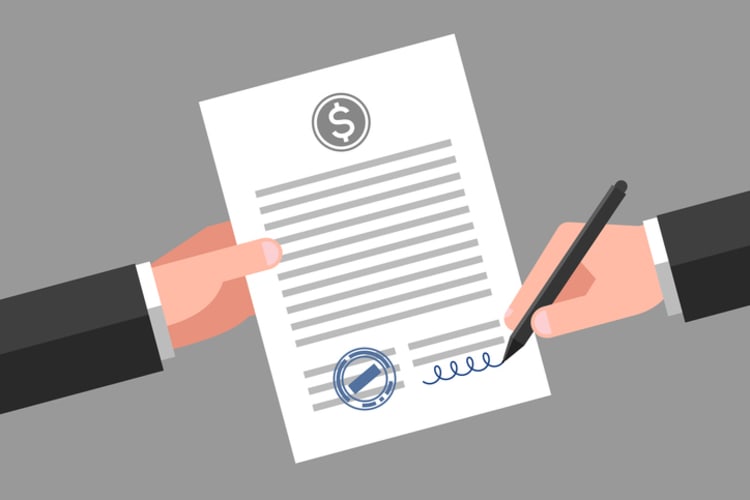Closing deals is the ultimate goal of every sales professional. But what if you could not only close deals but do so with ease and finesse? Imagine the impact on your career and your company’s bottom line. In this blog post, we’ll reveal proven strategies and techniques that will help you master the art of “how to close a deal” and transform your sales success. Are you ready to elevate your sales game?
Key takeaways
- Master proven sales strategies & techniques to close deals and succeed in today’s competitive market.
- Develop active listening, objection handling, and negotiation skills to increase success rate.
- Prepare for the close by setting clear expectations with a motivating tone and reviewing key points.
Understanding the sales process

The sales process is like a well-choreographed dance, where every step must flow seamlessly into the next. Mastering sales closing techniques requires a thorough understanding of the sales process, as it involves identifying qualified prospects, building relationships, and presenting tailored solutions to address the prospect’s pain points.
A sales professional who understands this process is better equipped to close deals by anticipating and addressing potential objections, guiding prospects through the sales cycle, and ultimately getting them to sign on the dotted line. This knowledge is crucial for sales teams to succeed in today’s competitive market.
Identifying Prospects
Finding and qualifying potential customers is the first step in the sales process. Identifying qualified prospects that match your ideal customer profile is a critical first step. To ensure you’re working with the right prospects, use a sales strategy called disqualification. This process involves asking questions to determine if the prospect is a fit for your offering, saving you time and effort by focusing on those most likely to close a sale.
Disqualifying prospects earlier in the sales process can help you avoid future objections and focus on sealing the deal. A well-defined ideal customer profile allows you to quickly and precisely identify the most promising leads for your business, ensuring a healthy sales pipeline.
Starting your sales process on the right foot entails understanding the cost of a prospect’s challenges and asking important qualifying questions before connecting with potential customers.
Building Relationships
Sales success hinges on the ability to build genuine relationships with prospects. It involves actively engaging with individuals, listening to their needs and concerns, and finding common ground to build a strong, positive relationship based on trust, rapport, and mutual understanding. The benefits of relationship building include strong personal connections, successful professional networking, and mutually beneficial business partnerships.
To foster strong relationships, actively engage with individuals, listen to their needs and concerns, and discover common ground to build a strong, positive relationship. Be genuine and authentic in your interactions, and demonstrate a genuine interest in the other person. Cultivating relationships can lead to increased trust, improved communication, and heightened collaboration, ultimately resulting in increased sales, better customer service, and more prosperous business partnerships.
Presenting Solutions
Once you’ve identified prospects and built relationships with them, it’s time to showcase how your product or service can effectively tackle their prospect’s pain points and provide tangible outcomes. Presenting prospects with tailored solutions is extremely effective, since it showcases your authentic commitment to addressing their pain points and yielding tangible results.
To succeed in presenting solutions, focus on addressing the prospect’s specific challenges and emphasize the value your product or service brings to their situation. Be honest about who your product or service is best suited for during the sales process. This approach can help you build trust with potential customers and maintain a positive reputation in today’s world of real-time access to information on the Internet.
Essential Skills for Closing Deals

Mastering essential skills such as active listening, handling objections, and negotiation can significantly enhance your chances of closing deals. These skills not only help you navigate the sales process but also enable you to address any lingering concerns the prospect may have, thereby increasing the likelihood of a successful close.
Honing these skills enables you to guide prospects confidently through the sales cycle, address their needs and pain points, and successfully seal the deal.
Active Listening
Active listening is a powerful communication technique that involves:
- Paying attention to, understanding, and responding to the speaker
- Giving your full attention to the speaker and avoiding distractions
- Providing verbal and nonverbal feedback to demonstrate understanding and engagement
Actively listening to your prospects ensures you truly comprehend their concerns and needs, allowing you to tailor your pitch effectively and address any potential objections.
To hone your active listening skills, pay close attention to the speaker, resist the temptation of any distractions, and offer verbal and nonverbal feedback to demonstrate comprehension and involvement. By demonstrating active listening, you can build strong relationships, improve understanding, and foster rapport with your prospects, which can ultimately lead to more successful sales conversations and closed deals.
Handling Objections
Anticipating and addressing common objections is a key skill for successfully closing deals. Objection handling involves:
- Attentively listening to the customer’s objections
- Understanding their concerns
- Offering relevant information or solutions to address their doubts and progress the sales process.
Effectively handling objections can help you foster strong relationships with customers, address their concerns, and ultimately close more deals. By being prepared for sales objections and crafting clear, concise responses, you can confidently address any lingering concerns your prospect may have.
Additionally, getting insights from your team and practicing your responses until you can confidently deliver them can further enhance your ability to handle objections and close deals successfully.
Negotiation
Negotiation is an art that involves discussion and communication between two or more parties with the goal of achieving a mutually beneficial agreement or resolving a conflict. Developing negotiation skills is essential to reach mutually beneficial agreements and close deals successfully. By understanding the negotiation process, which typically involves:
- Preparation
- Opening
- Bargaining
- Closing
You can increase your chances of success in closing deals.
To be better prepared for successful negotiation, follow these steps:
- Be well-informed
- Listen attentively
- Understand the other party’s objectives
- Be open to different possibilities
By employing these effective negotiation tactics, you can navigate challenging sales conversations, address the prospect’s concerns, and ultimately reach a successful close.
Top Sales Closing Techniques

Sealing the deal requires the utilization of proven sales closing techniques and effective sales closing strategies. By mastering a sales closing technique, such as the assumptive close, now or never close, and takeaway close, you can close deals with confidence and finesse. This will enhance your sales success.
Mastering these techniques enhances your ability to effectively navigate the sales cycle, anticipate objections, and steer prospects towards a mutually beneficial decision.
The Assumptive Close
The assumptive close is a powerful psychological selling technique that projects complete confidence in your product, influencing the prospect’s buying decision. With this technique, you assume the sale is a done deal and use positive language to encourage the prospect to commit. This approach works best when you already know the lead and the product is exactly what the prospect needs.
To make the most of the assumptive close, speak as though the prospect has already bought the product and see the impact it has on their decision-making process. By projecting confidence and emphasizing the benefits of your offering, you can inspire the prospect to take action and sign the deal.
The Now or Never Close
The now or never close creates a sense of urgency by offering exclusive incentives for a limited time, prompting immediate action from the prospect. By emphasizing the limited time or availability of the offer and highlighting the potential consequences of not taking action now, you can help your prospects make a decision quickly.
This technique is particularly effective in overcoming objections and securing a commitment from the prospect. The now or never close encourages prospects to take immediate advantage of the offer before it expires, thus increasing the likelihood of a successful close.
The Takeaway Close
The takeaway close involves:
- Outlining the advantages and value of your product or service
- ‘Taking away’ or removing the offer or discount to drive the prospect to take action
- Highlighting the value of what’s being taken away
- Removing features or options for prospects who object to the price
By using the takeaway close, also known as the puppy dog close, you can create a sense of urgency and persuade the prospect to make a decision.
This technique is especially useful when dealing with price objections, as it emphasizes the value and return on investment your product or service provides. By employing the takeaway close, you can motivate prospects to act and close the deal quickly, ultimately boosting your sales success.
Effective Communication Strategies

Successful sales are fundamentally rooted in effective communication and well-planned sales strategies. By tailoring your message, using storytelling, and employing visual aids, you can engage prospects and make your pitch more memorable.
Enhancing your communication skills not only helps you build rapport with prospects but also enables you to address their unique needs and concerns, increasing the likelihood of a successful close.
Tailoring Your Message
Customizing your pitch to address the unique needs and concerns of each prospect is an essential aspect of effective communication. By adapting your language, tone, content, and delivery style, you can ensure that your message resonates with your intended recipients.
When crafting a message for each prospect, take into account their individual characteristics, such as their age, gender, culture, and interests, as well as their budget, timeline, and desired outcomes.
By tailoring your message to each prospect’s unique needs and concerns, you can create an impactful message that speaks directly to their individual needs. This approach not only helps you communicate more effectively but also increases engagement and improves understanding, ultimately leading to more successful sales conversations and closed deals.
Using Storytelling
Sharing relatable stories and case studies is a powerful way to demonstrate the value of your product or service and build an emotional connection with the prospect. Storytelling involves using characters, plot, and setting to engage and enthrall an audience. It can be used in various forms, such as:
- books
- movies
- presentations
- marketing campaigns
To effectively communicate ideas and stir emotions is only half the battle.
By incorporating storytelling into your sales pitch, you can make complex concepts easier to understand, stand out from the competition, and create a memorable experience for the prospect. Sharing stories of how your product or service has helped other customers and providing case studies of successful implementations can help you build trust and persuade the prospect to take action.
Employing Visual Aids
Using visuals such as presentations, videos, and infographics can support your pitch and make it more memorable for the prospect. Visual aids are effective tools for engaging an audience and conveying information in a clear, concise manner. They can include images, charts, graphs, diagrams, videos, or any other visual representation that helps make a presentation or communication more impactful.
To make the most of visual aids, ensure they’re simple, relevant, and easy to understand. Practice using them before the presentation to ensure they’re working properly, and use them to support the main points of your presentation. By employing visual aids in your sales pitch, you can make complex concepts easier to understand, build a stronger connection with the prospect, and ultimately increase your chances of closing the deal.
Overcoming Common Sales Obstacles

Closing deals significantly involves tackling common sales challenges. By addressing price objections, differentiating your offering from competitors, and handling timing concerns, you can move prospects closer to a sales deal decision.
Mastering these techniques can help you navigate the sales process more effectively and ultimately close more deals.
Price Objections

Addressing pricing concerns is essential for sales success. By emphasizing the value and return on investment your product or service provides, you can overcome price objections and persuade the prospect to move forward with the purchase. Explaining how the product or service can save the customer time and money in the long run, or how it can help them achieve their goals more quickly, can also help mitigate price objections.
By offering discounts or other incentives, you can make the product or service even more enticing to the customer, ultimately increasing the likelihood of a successful close. Addressing price objections effectively can help you build trust with potential customers, maintain a positive reputation, and ultimately close more deals.
Competition
Differentiating your offering from competitors is essential for closing deals. By highlighting unique features, benefits, and customer success stories, you can help your offering stand out from the competition and make it more appealing to potential customers.
Emphasizing the unique aspects of your product or service, such as special features or capabilities that competitors do not offer, can result in cost savings, convenience, and other advantages for the customer. By showcasing these unique benefits, you can gain an edge over the competition and persuade the prospect to choose your offering over others, focusing on not just the product but also its distinctive qualities.
Timing Concerns
Addressing timing objections can be challenging but is essential for moving prospects closer to a decision. By creating a sense of urgency or demonstrating the potential cost of inaction, you can overcome timing concerns and persuade the prospect to take action.
Emphasizing the fleeting availability of the offer, the fleeting time frame for taking advantage of the offer, or the potential consequences of not taking action can help create a sense of urgency and persuade the prospect to make a decision. By addressing timing concerns effectively, you can increase the likelihood of a successful close and ultimately boost your sales success.
Preparing for the Close

Setting the stage for a successful close involves setting clear expectations, confirming understanding, and reviewing key points. By ensuring both you and the prospect are on the same page, you can move the sales process forward and increase the likelihood of a successful close.
Navigating the sales cycle and ultimately closing sales necessitates adequate preparation for the close.
Setting Clear Expectations
Keeping the sales process moving forward requires establishing a mutual understanding of the next steps and desired outcomes. By setting clear expectations, you can minimize misunderstandings, improve accountability, and enhance productivity.
Clear expectations provide a comprehensive understanding of what is expected from individuals or teams in terms of performance, behavior, and results. Setting deadlines, providing detailed instructions, and establishing performance metrics are all great ways to ensure clear expectations and foster motivation.
Confirming Understanding
Ensuring that the prospect fully comprehends the value and benefits of your offering is a crucial step before moving to the close. Confirming understanding is a powerful communication technique that involves summarizing and restating key points, asking clarifying questions, and actively listening to the other person’s response to confirm comprehension.
By confirming understanding, you can address any lingering concerns the prospect may have and move the sales process forward. This technique not only helps you communicate more effectively but also increases engagement and improves understanding, ultimately leading to more successful sales conversations and closed deals.
Reviewing Key Points
Approaching the close necessitates reviewing the most important aspects of your pitch and addressing any lingering concerns before asking for the sale. By summarizing the key points, you can reinforce the value and benefits of your offering and ensure the prospect understands how it can help them achieve their goals.
Reviewing key points also provides an opportunity to address any remaining objections the prospect may have, ensuring they are confident in their decision to move forward with the purchase. By taking the time to review the key points and address any lingering concerns, you can increase the likelihood of a successful close and ultimately boost your sales success.
Summary
In conclusion, mastering the art of closing deals is a game-changer for sales professionals. By understanding the sales process, developing essential skills, utilizing proven closing techniques, and employing effective communication strategies, you can transform your sales success. Overcoming common sales obstacles and preparing for the close will set the stage for a successful close and ultimately seal the deal. Embrace these proven strategies and techniques, and watch your sales career soar to new heights!
Frequently Asked Questions
The best way to close a deal is to identify customer needs, find the decision-maker, initiate a conversation, explain the product's benefits, create a sense of urgency, anticipate and prepare to address objections, use now or never closes, and summarize closes. These steps can help you close a deal quickly and effectively. Start by understanding the customer's needs and finding the decision-maker. Then, initiate a conversation and explain the product's benefits. Create a sense of urgency and anticipate objections. Finally, use now or never closes and summarize closes to close the deal.
Closing deals effectively requires three key techniques: The assumptive close, the gauge technique, and the summary close. Avoid the fourth technique, unless absolutely necessary.
Developing active listening, objection-handling, and negotiation skills are key to successfully closing deals.
Tailor your message to the prospect's unique needs, use storytelling and visual aids to motivate and engage them, and make sure to use a positive, motivating tone to make your pitch more memorable. Be sure to break up your text into paragraphs to make it easier to read. This will help your readers understand your message more clearly and quickly.
Focus on the value of your product or service and consider discounts or incentives to encourage customers to buy. This will help address price objections during the sales process.





